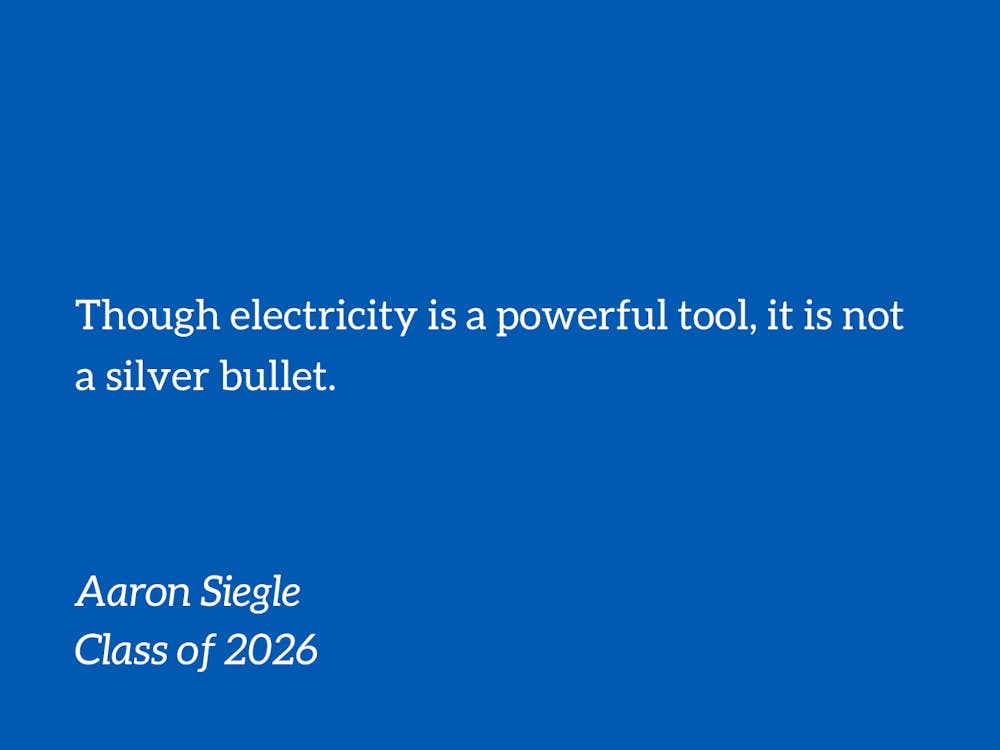Ever since Michael Faraday’s discovery of electromagnetic fields in 1831, electric power has been heralded as the ultimate human achievement. Now, as humanity is beginning to recognize the importance of tackling climate change, electrification is touted as the best path forward.
It is widely agreed that the converting more energy uses to electricity is our best shot at tackling climate change. However, the "electrify everything" approach overlooks two major challenges. First, many activities, such as aviation and heavy industry, cannot be feasibly electrified. This is because electricity does not have a high enough energy density to fuel these extremely energy-intense activities. Second, the grid needed to supply electricity is massively inefficient and struggling to keep up with rising demand. In other words, we need to make better use of the electricity that we already have before we switch over more end uses toward electricity. By integrating electrification with broader energy-efficiency efforts and tailoring decarbonization for a diversity of scenarios, only then can we achieve our climate goals.
The benefits of electricity are manifold. Because voltages can be stepped down (which transitions more of the energy to current as opposed to voltage, making the electricity safer), power can come into our homes at safe levels. Electricity can be generated at one location and consumed hundreds of miles away, interconnecting large regions. From a decarbonization perspective, almost all carbon-free sources, ranging from solar to nuclear, run on electricity.
The "electrify everything" strategy is twofold. First, devices that previously ran on fossil fuels are replaced with those that run on electricity. This means replacing internal combustion engine (ICE) vehicles with electric vehicles, gas stoves with electric stoves and gas furnaces with electric heat pumps. Second, the generating sources of the electricity must be clean. Coal and natural gas plants must be retired in favor of solar, wind and nuclear. If these two goals can be accomplished, then our entire economy can run on electric devices powered by clean electrons — or so the thinking goes.
However, going all in on electricity has its own drawbacks. The American electric grid was largely built over a half-century ago and is starting to show signs of its age. Furthermore, this old infrastructure is struggling to keep up with skyrocketing power demand largely driven by the growth of data centers to power AI. Having all systems run on electricity creates the risk of single-point failures. If the power goes out, then society shuts down. Finally, not all sources of emissions can simply be switched over to electricity. Agriculture, aviation and heavy industry — sectors comprising roughly 20% of America’s emissions, do not have viable electric alternatives.
That’s why we need to take a whole system approach when reducing emissions. Rather than switching in an electric replacement for our current technology, we should use the energy transition as an opportunity to reassess our relationship with technology as a whole. For example, take electric vehicles, a key component of the "electrify everything" strategy. Instead of just replacing ICE vehicles with electric vehicles, decarbonization should entail designing more walkable cities to reduce car dependency. And investing in intercity rail to provide alternatives to flying or driving for long-haul trips. Our current economy is stuck on a path of dependency on fossil fuels. When building the green economy, we must be mindful of the unintentional path dependencies we are creating.
A core component of this is making the grid more efficient. Currently, renewable energy developers are waiting an average of five years to connect their projects to the grid due to limited transmission capacity. However, transmission lines can actually carry much more electricity than they are currently allowed due to inflexible regulations that fail to consider dynamic environmental conditions. Think about it like setting the speed limit on the interstate to 20 mph for the entire year because that is the safest speed to drive on a snowy winter day. Furthermore, transmission technology such as improved conductors can further maximize the efficiency of the infrastructure we already have in place.
So, what can be done to decarbonize the things that we can’t electrify? First, we can work to drive down unnecessary uses of power. Much energy is wasted on unproductive activities or in circumstances where consumers don’t fully understand the environmental footprint of their actions, notably when using crypto and AI. Cryptocurrency mining should switch from proof-of-work to proof-of-stake, a shift that would result in a 99% emissions reduction without impacting crypto trading. Also, consumers should avoid wasteful uses of AI. An average ChatGPT query uses 2.9 Watt-hours (Wh) of electricity, 10 times the amount of a Google search. Goofy image generation and using ChatGPT as a calculator is killing our planet.
Second, energy efficiency needs to be a central tenet of the electrify everything strategy. Instituting dynamic line ratings and reconductoring existing transmission lines will make existing energy sources go further. Promoting demand response programs and encouraging distributed energy generation will limit the amount of electricity wasted.
Third, more investment is needed in difficult to electrify sectors. Creating carbon neutral alternatives to cement and steel is a capital-intensive endeavor that will take patience. The same goes for sustainable aviation fuels. While these new technologies mature, simple fixes, such as planting cover crops in agriculture, are important first steps to cracking difficult to decarbonize sectors.
Though electricity is a powerful tool, it is not a silver bullet. Communities and industries need to take a wholistic view of sustainability that goes beyond a carbon-emissions balance sheet. Before we can electrify everything, we must be realistic about what we can’t electrify.
Aaron Siegle is a Trinity junior. His pieces typically run on alternate Fridays.
Get The Chronicle straight to your inbox
Sign up for our weekly newsletter. Cancel at any time.

